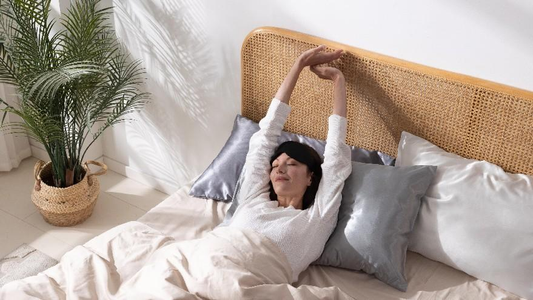What are the best bedroom colors for sleeping?
The color of your bedroom can indeed have an impact on your sleep and overall relaxation. Generally, calming and muted colors tend to be more conducive to a restful environment. Here are some colors often recommended for promoting a relaxing atmosphere in the bedroom:
- Soft Blues: Light shades of blue are often associated with calmness and tranquility. Blue has been shown in some studies to reduce blood pressure and heart rate.
- Soft Greens: Green is also considered a calming color and is associated with nature. Soft greens can create a soothing and restful atmosphere.

- Neutral Tones: Colors like beige, taupe, or light gray can create a neutral and calming backdrop. These colors are versatile and can be easily complemented with other soothing elements. https://egohome.com/collections/bedding
- Lavender: Lavender, or light purple, is often associated with relaxation and has been used for its calming properties. It can be a good choice for a serene bedroom.
- Soft Grays: Light and soft shades of gray can create a calming and sophisticated environment. Gray can also serve as a neutral backdrop for other calming elements in the room.

https://egohome.com/products/platform-hb-dg-v6
It's important to note that individual preferences can vary, and what matters most is creating a space that makes you feel comfortable and relaxed. Additionally, consider the lighting in your bedroom, as warm and dim lighting can contribute to a cozy and calming atmosphere.
Avoiding bright, stimulating colors and opting for softer, muted tones can contribute to a more restful and sleep-friendly environment. It's always a good idea to test colors in small sections before committing to painting an entire room to see how they make you feel in different lighting conditions.
What Color Light Helps You Sleep Better?
Light color can indeed have an impact on your sleep, particularly in the evening when you're winding down. Exposure to blue light, which is common in many electronic devices and energy-efficient LED lights, can suppress melatonin production and disrupt the circadian rhythm, making it more challenging to fall asleep.
On the other hand, warmer colors with lower color temperatures, such as red, orange, and yellow, have less impact on melatonin and circadian rhythm, making them more conducive to better sleep. Warm or soft white light is generally recommended for the evening hours.
Here are some tips for using light to promote better sleep:
- Dim the Lights:
In the evening, start dimming the lights in your home to signal to your body that it's time to wind down.
Consider using dimmable lights or lamps to create a softer, more relaxing atmosphere.
- Use Warm-Toned Bulbs:
Choose light bulbs with a color temperature of around 2700K or lower for your bedroom. These are in the warm white or soft white range.
- Limit Blue Light Exposure:
If you must use screens, consider using apps or settings that reduce the amount of blue light emitted.
- Bedside Lamps:
Use bedside lamps with warm-colored bulbs to create a relaxing environment before sleep.

- Candlelight:
Consider using candles with warm-colored flames for a calming and natural light source.
Creating a sleep-friendly environment involves a combination of factors, and lighting is just one aspect. Consistent sleep-wake schedules, a comfortable mattress and pillows, and a relaxing bedtime routine also play crucial roles in promoting healthy sleep.
Good Night, My Dear!


